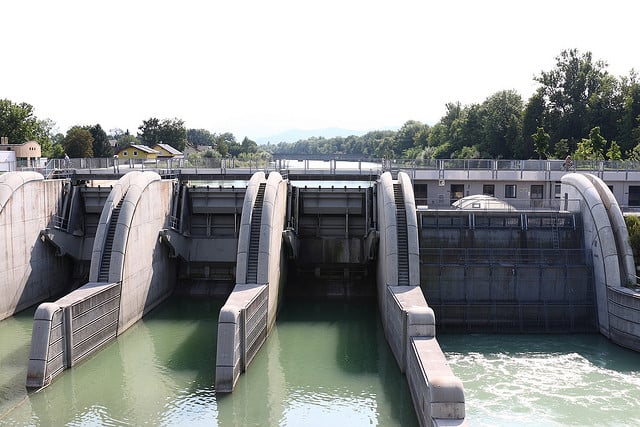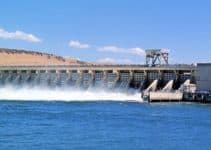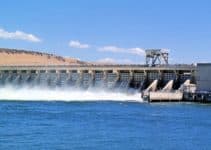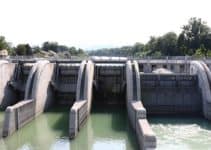Although renewable sources of energy such as solar and wind are fast catching up with the evaporating hydroelectric power, it still holds the largest share of the global electricity. In fact, in the 20th century, hydroelectric power was so large that it was called white coal for its power and plenty. Hydroelectric power was the first and simplest electricity generation technology.
The initial production utilized timber, granite block and low dam of rock construction to gather water from surface runoff and rainfall into a reservoir. The water was then channeled to a pipe and then to a water wheel (turbine). The channeled water fell on a turbine blade spinning it and the connected shaft.
The shaft was connected to a standby generator that produced electricity when rotated. The technology has since grown by leaps and bounds, and the water is mostly collected from falling and flowing rivers. The technologies used today include impoundment, diversion, and pumped storage hydropower.
Hydroelectric power is classified as a renewable energy resource. Why? Because of the water. You see water vaporizes into clouds and recycles back to the surface of the earth as precipitation. The water cycle is continually revitalized and can be utilized to generate electricity over and over
Hydroelectric power simply means the generation of power from falling or streaming water. To produce power, dams are constructed on rivers. The constant running flow of water is then used to move the turbines.
The rotating turbines then use the kinetic energy of moving water which in turn causes the magnets inside the generator to rotate and generate electricity. The water then exits the turbine and is returned to the stream below the dam. Moving water is therefore a powerful source of energy that can lighten cities, towns and even countries.
Although producing of energy through hydropower does not emit any greenhouse gases but the building of huge dams on the rivers and blocking them can have serious environmental and social effects in the form of altering the normal flow of the river, blocking of migratory fish passage, a sudden occurrence of floods, increase in a number of earthquakes and displacing of local communities.
In this article, we’re going to explore both the pros and the cons so you can have a better idea of what is being discussed in regards to hydroelectric power.
Pros of Hydroelectric Power
1. Renewable Energy Source
Hydroelectric energy is renewable. It is considered as renewable because it uses the earth’s water to produce electricity. The sun shines and the water evaporates from the earth’s surface, forms clouds and then falls back on to the earth in the form of rain and snow. Rivers and lakes that are typically leveraged to generate hydroelectric power will never disappear
This implies that we can’t use it up and we don’t have to worry about it becoming more expensive because of scarcity. On the other hand, there are just a few suitable repositories where hydroelectric power plants could be built and fewer places where such undertakings are beneficial.
2. Clean Energy Source
As you may expect, hydroelectric power is one of the “green” and “clean” alternative energy sources that are out there. Creating power with hydroelectric energy is not contaminating itself. The energy produced by hydroelectric plants do not produce any toxic or greenhouse gases that pollute the atmosphere. The main contamination happens when the power plants are being built.
The hydroelectric plants emit fewer greenhouse gasses than fossil based power sources, which helps mitigate climate change, acid rains, and smog. Hydroelectric power also improves the air quality we breathe because they don’t emit air pollutants. On top of that, the pants don’t produce toxic byproducts.
3. Cost Competitive Energy Source
Hydroelectric power is a cost-competitive source of energy even though the upfront building costs can be high. River water is an infinite resource, which is not affected, whatsoever, by market volatility. Fossil fuel-based energy sources like coal, oil and natural gas are deeply affected by market volatility, which drives up or considerably lower their prices.
Hydroelectric power plants have an average lifetime of 50 – 100 years, meaning they are strategic investments that can support many future generations. They can also be easily upgraded to fall in line with the modern day’s technological requirements and have considerably lower operating and maintenance costs.
4. Contributes to the Development of Remote Communities
Hydroelectric power plants supply electricity to remote communities, attract construction of highways, industry, and commerce. All these activities serve to uplift the economy of these remote areas, increase access to education and healthcare and enhance the overall life quality of residents.
Hydroelectricity technology has been quantified for over a century. People have already come to grips with its effects through steps for prevention and compensation of damages. It’s almost always available where development is needed.
5. Recreational Opportunities
The lake that forms behind the dam can be used for recreational opportunities, offering activities such as fishing, boating and swimming. The lake’s water can also be used for irrigation purposes. Apart from this, large dams become a hotspot for tourist attractions.
Hydroelectric power plants have the capacity to store vast quantities of water for irrigation when rainfall disappears and for consumption when there is a shortage. The ability to store water is advantageous since it shields water tables from exhaustion and minimizes our susceptibility to droughts and floods.
6. Fundamental Vehicle for Sustainable Development
Energy technologies instituted and run in environmentally sensible, economically viable and socially responsible models symbolize the greatest concepts of sustainable development. This means development models in the present day that addresses individuals’ needs without affecting the capability of coming generations for tackling their own needs. Hydroelectric power is among these energy technologies.
Cons of Hydroelectric Power
1. Environmental Damage
Interruptions of natural water flow can have a great impact on the river ecosystem and the environment. Some fish species and other creatures normally migrate when there is food shortage or when the breeding season begins. The building of dams could cut off their paths leading to a lack of reproduction or fish deaths.
The natural results of hydropower are identified with intercessions in nature because of damming of water, altered water flow, and the development of streets and power lines.
Hydroelectric power plants may influence fish and the way that they move and migrate, but this is a complicated process to research and it is hard to make a determination based on that one factor. More client investments identified with abuse of fish species, which means that this is a field that a number of people have strong feelings about.
2. High Upfront Capital Costs
Power plants can be incredibly expensive to build, no matter what type you maybe building. Hydroelectric power plants are not a special case to this. Hydroelectric power plants are very costly to construct due to logistical challenges like topography, laying foundations underwater and the materials used to build it.
The only upside is that after completion, it will require less maintenance. Still, the hydroelectric plant will have to operate for a long time to recoup the money injected into the construction.
3. Might Cause Conflicts
Countries that harbor rich sources of hydroelectric power typically build dams across the river to harness the water. While this act is laudable, it can result in interruption of natural water flow from one specific direction to another.
When a particular location doesn’t require a lot of water, it is channeled to another location to cater for those wanting to build dams in those locations. However, if the scarcity of water hits that particular area, it can trigger off conflict, and this means water channeled to the dams have to be halted.
4. May Lead to Droughts
One of the main downsides to setting up hydroelectric power plants is the risk of local droughts. The overall energy and power costs are discovered depending upon water accessibility. Accessibility of water can be significantly impacted by dry spells leading to individuals not accessing the electricity they need.
5. Risk of Floods in Lower Elevations
Communities living downstream are vulnerable to flooding should strong water currents be released from the dam. In the long run, the livelihood of people living in those areas might be destroyed.
6. Carbon dioxide and Methane Emission
The hydroelectric power reservoir emits vast quantities of carbon dioxide and methane. These areas near the dam are full of water, and the plants underneath the water begin to rot and decompose. This kind of decomposition without oxygen involvement gives off vast amounts of carbon dioxide and methane, which leads to an increase in pollution levels.
7. Geological Damage
Construction of large-scale dams can contribute to grave geological damage. A classic example of geological damage is the construction of the Hoover Dam in the United States that caused earthquakes and led to the depression of the earth’ surface in the area.
8. Concerns About the Safety of the Dam
The safety of the dam is paramount for the nearby population. In the modern-day where acts of terror are rife, dams can be a major target to kill thousands of people. This is why after construction and fully operational, the dam has to be accorded maximum security. Security adds up the overall cost of constructing a hydropower plant.
People living along low lying areas are often in the danger of floods as the areas might get swept away when water is released in full force from the dam. Apart from this, these people are forcibly moved out so that construction of these dams can continue.
Construction of dams in specific areas with the ability to generate vast amounts of power can present a myriad of challenges. Even though hydroelectric power plants comes with many benefits to the end-user, variables exist that can hold back their development. With that reason in mind, it’s prudent to weigh the pros and cons of this form of energy when looking to construct one.
A good course of action is to thoroughly analyze local statistics prior to building up an innovative structure in the area. The many key considerations are that the dam should not affect the people and environment around. It should also be in line with the local safety requirements.



